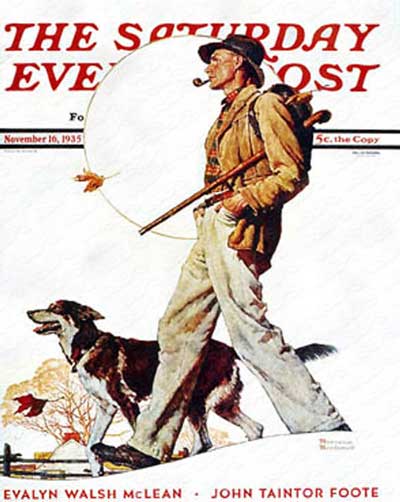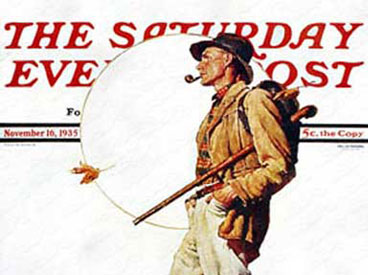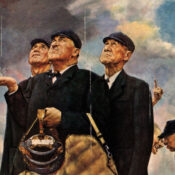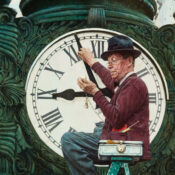
Norman Rockwell was a child of the city, raised in the mean streets of Manhattan in the late 1800s. As a New Yorker, he idealized certain aspects of country life as only a city slicker can. The man and his dog taking a stroll in the fresh air was little more than a dream at the time this cover was created.
The idea for the painting actually originated with the model, Walter Botts, whom Norman and his new wife Mary met in 1930 in New York as the artist was introducing her to his circle of friends. Walter and Mary hit it off when they discovered that they were both from the Midwest. Walter was describing his hometown and spoke fondly of his Hoosier roots and his love of wandering the countryside of south central Indiana as a kid.
Nothing came of the meeting right away, but the idealized vision of a bracing walk in the country had lodged in the artist’s mind. Five years later, Norman, Mary, and their two sons Jerry and Tommy (third son Peter was born in 1936), left New York to vacation at Mary’s family home in southern California. This was to be a working vacation for the artist, who visited Hollywood to do a radio show and made a point of seeing a string of potential models. As luck would have it, one of the models was Walter, now living in Los Angeles.
Was it fate that brought the two men together again? Norman had already made a preliminary sketch of the man-with-a-dog scene Walter had described five years earlier, but he’d done so using a different model. It was Mary who suggested Norman redo the illustration using Walter. After all, she pointed out, it was Walter who had been the original inspiration for the idea.
Norman always loved this painting for its reflection of the country life he aspired to. Sure enough, three years after completing the work, he and his family would relocate from the New York suburbs to southern Vermont. The dream became a reality.
As an interesting footnote, in 1938, model Walter’s face became familiar to millions as Uncle Sam in the World War II recruiting posters entitled, “I Want You.” Artist James Montgomery Flagg chose the model because he had “the longest arms, the longest nose, and the bushiest eyebrows,” according to James’ widow’s memoir. As the story goes, when James asked Walter what he was going to do with those long arms, the model suggested the persuasive pointing gesture. And the rest, as they say, is history.
To order a print, visit saturdayeveningpost.com/autumn-stroll.
Become a Saturday Evening Post member and enjoy unlimited access. Subscribe now




Comments
Walter Botts was my great great uncle so this is such a special insight into him. So glad a came across this article!
I found this article very interesting because I had always thought that Fred Hildebrandt was the hunter model used for the November 16, 1935 “Post” cover. It was when Fred was modeling that Rockwell gave Fred a charcoal drawing he had used in preparation for the June 30, 1934 “Post” “Vacation” cover. On that drawing Rockwell wrote, “To good old Fred” and then Rockwell signed the drawing.
I would love to see a photo of Walter Botts so I could decide if the “Post” hunter cover looks more like Fred Hildebrandt or more like Walter Botts.
This is very interesting feature of the-story-behind-the-cover. The fact that this “model”, Walter, and Norman Rockwell’s wife Mary were both from Indiana, make the it the perfect state to be the home of The Saturday Evening Post, which it’s been since 1971 after its brief ‘remodeling’ hiatus. Prior to that, its home had been New York City for most of the ’60s. So I think it was meant to be if I do say so myself!